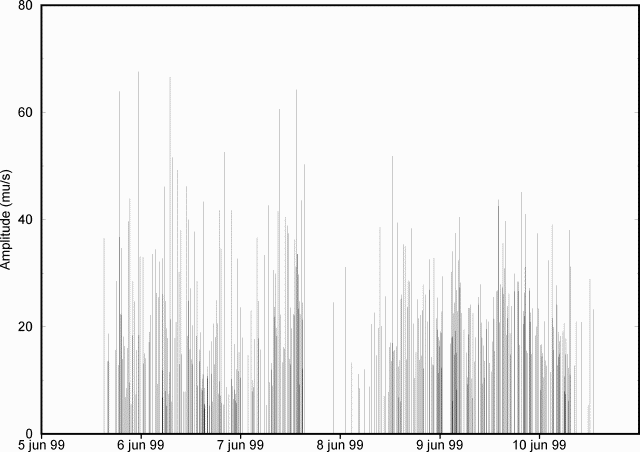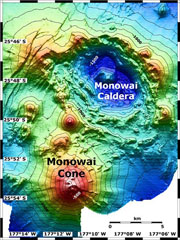Report on Monowai (New Zealand) — June 1999
Bulletin of the Global Volcanism Network, vol. 24, no. 6 (June 1999)
Managing Editor: Richard Wunderman.
Monowai (New Zealand) Strong acoustic crisis recorded during 5-10 June
Please cite this report as:
Global Volcanism Program, 1999. Report on Monowai (New Zealand) (Wunderman, R., ed.). Bulletin of the Global Volcanism Network, 24:6. Smithsonian Institution. https://doi.org/10.5479/si.GVP.BGVN199906-242050
Monowai
New Zealand
25.887°S, 177.188°W; summit elev. -132 m
All times are local (unless otherwise noted)
The French Polynesian Seismic Network recorded a strong acoustic crisis originating from Kermadec, very near Monowai Seamount, during 5-10 June. The acoustic crisis started at 0300 on 6 June (1500 on 5 June GMT) and ended at 0100 on 11 June (1300 on 10 June GMT) with no precursory activity (figure 7). Two distinct episodes were separated by a 4-hour period of inactivity. The network recorded more than 394 strong acoustic T-waves; the strongest took place at 1115 on 6 June (2315 on 5 June GMT). The first signal received on 6 June began with an impulse and lasted more than 12 minutes. Many of them had explosive characteristics, short and strong. The activity stopped with a small explosive T-wave. No tremor was recorded.
 |
Figure 7. Acoustic wave amplitudes recorded by the French Polynesian Seismic Network during 5-10 June. The source of these waves was near the Monowai Seamount. Courtesy of Olivier Hyvernaud. |
Monowai Seamount lies midway between the Kermadec and Tonga Islands, ~1,400 km NE of New Zealand. The adjacent trench is much shallower (~4 km) compared with the Tonga and Kermadec trenches (9-11 km deep). There was a T-wave swarm in November 1995 (BGVN 20:11/12). Other noteworthy recent activity at Monowai included a possible eruption in 1944, and about seven documented eruptions during 1977-90 (BGVN 16:03).
Geological Summary. Monowai, also known as Orion seamount, is a basaltic stratovolcano that rises from a depth of about 1,500 to within 100 m of the ocean surface about halfway between the Kermadec and Tonga island groups, at the southern end of the Tonga Ridge. Small cones occur on the N and W flanks, and an 8.5 x 11 km submarine caldera with a depth of more than 1,500 m lies to the NNE. Numerous eruptions have been identified using submarine acoustic signals since it was first recognized as a volcano in 1977. A shoal that had been reported in 1944 may have been a pumice raft or water disturbance due to degassing. Surface observations have included water discoloration, vigorous gas bubbling, and areas of upwelling water, sometimes accompanied by rumbling noises. It was named for one of the New Zealand Navy bathymetric survey ships that documented its morphology.
Information Contacts: Olivier Hyvernaud, Laboratoire de Géophysique, BP 640 Pamatai, Tahiti, French Polynesia.

